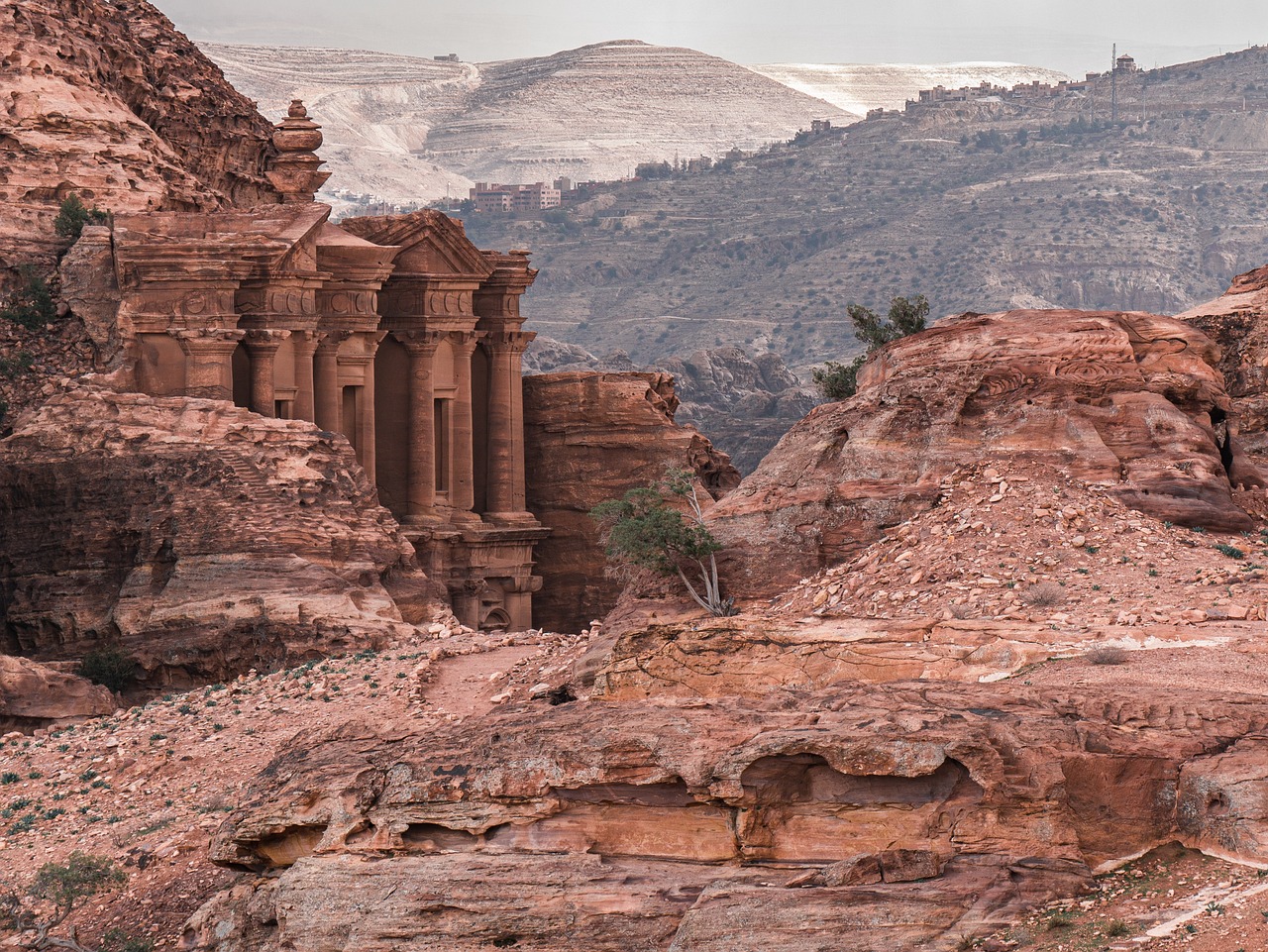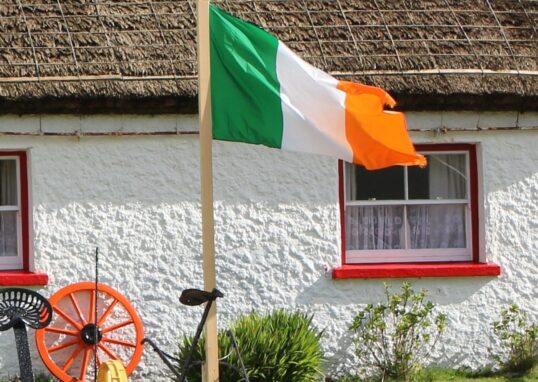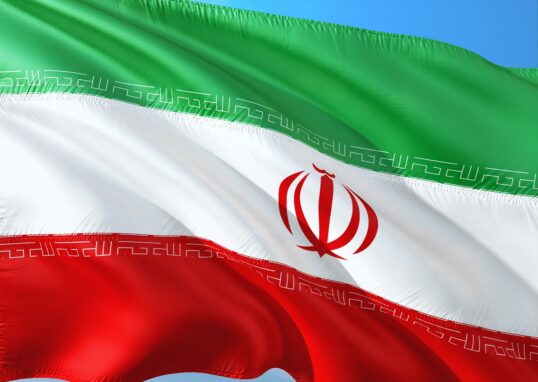
Symphony in Sandstone: The Lost City’s Eternal, Wind-Worn Hymn
Petra, often called the “Rose City” due to the pink-colored sandstone cliffs from which it emerges, is probably the world’s most iconic archaeological site. Carved into the edges of a mountain range in southern Jordan, this ancient Nabatean city dates back to around 300 BCE and is both a UNESCO World Heritage Site and one of the New Seven Wonders of the World. Petra is located in southern Jordan, and this city was the capital of King Aretas IV, the Nabataean Kingdom, and one of the New Seven Wonders of the World.
Petra Jordan, an unforgettable sight
Key Attractions
Al-Khazneh (The Treasury)
Petra’s most famous landmark, the Treasury (Al-Khazneh), is located at the end of the narrow CQ, a dramatic valley that is the city’s main entrance. Treasure’s complex carvings and gigantic masks testify to the neighbors ‘ simplicity and art.
Iconic Facade
The Al-Khazneh, the most celebrated structure at Petra, has a blessed wall engraved from a sandstone cliff right next to it. It is 39.1 meters (128 ft) tall, and locals say it was either a mausoleum or a temple, but there is no clear indication of what the purpose was.
Myth and Legend
The Treasury owes its name to local Bedouin legends about the treasure supposedly hidden in that building.
The Siq
Dramatic Entrance
The Siq is about 1.2 kilometers (0.75 miles) long, and the walls are sixty meters (197 feet) tall and 80 meters (260 feet) high.
Water Channels
Along the walls of the Siq, you can see the remnants of ancient water channels that once provided Petra with its water supply.
The Monastery (Ad Deir)
Larger than the Treasury
This shrine is another big mountain house, along with The Treasury, of similar soaring ascension, 47 meters (114 feet) high and 48.3 meters (100 feet) wide. It was built by Nabataean engineers and could be entered through a series of footpaths that wind through the mountain, but it requires a steep climb of around 800 steps, which, however, is compensated by the breathtaking views of the location.
Religious Significance
The Monastery could be a place where religious ceremonies might have taken place, probably a Nabataean temple.
The Royal Tombs
Elaborate Burial Sites
Notable among the tombs are the honeycombed cliffs, which are crammed with big funerary structures like the Urn Tomb, the Silk Tomb, the Corinthian Tomb, and the Palace Tomb. These are supposed to have belonged to Petra’s rulers and high officials.
Architecture
The outer walls of the burials tell of the Nabataeans’ deep ability to build, integrating characters from Hellenistic, Egyptian, and native societies.
The Great Temple
Beyond the Treasury, Petra is a large archaeological site in Jordan where you can discover many graves, temples, and monuments. The monastery (AD-Deir) provides elevated, fantastic views on a mountain and has a different attraction, although it requires challenging hiking to reach. The Royal Tomb, Roman Theater, and Colonnaded Street provide further insight into the city’s history as a prosperous trade hub. The high sacrificial site offers a panoramic view of Petra and is a sacred place where old rituals were performed.
Archaeological Wonder
The Great Temple, which is now a hub of religious and social activity, was a sprawling complex of worship and interactive activities in ancient times. The person who conducted the excavation pointed out that the floor mosaics were detailed, and the staircases and colonnades were defined. These gave the site significance. Petra’s society.
Nabataean Engineering
The temple is undoubtedly a perfect instance of the advanced engineering techniques employed by the Nabataeans, including their use of water channels and cisterns.
The High Place of Sacrifice
Panoramic Views
The High Place of Sacrifice, located at a great height and ascent reached sharply, provides enchanting views of the landscape, Petra, and the surrounding mountains. The area was once used for the convenience of divine sacrifice, which involved killing animals.
Sacrificial Altars
At the summit, you can see two obelisks and an altar, where offerings to the gods were made.
The landscape around Petra is also immersed in history and natural miracles. Little Petra, located north of the most important archaeological site, is a low but equally complicated place with intact carvings and buildings. The Wadi Rum Desert, or which is sometimes referred to as “Moon of Moon”, is just a small drive from Petra and claims the wonderful expanses of the red dunes, dramatic rock structures and star-controlled skies. Wadi Rum has become a favorite among jeep tour visitors, camel tours, and desert camping, which allows a most unusual desert experience.
Another close-by attraction is the Dana Biosphere Reserve, Jordan’s largest nature reserve. This mixed environment accommodates various species of wildlife, including the threatened Nubian ibex, and provides hiking and eco-tourism opportunities. Shobak Castle is a Crusader’s castle located on a height. It provides information on the region’s medieval past and fantastic views of the surrounding landscape.
History and Cultural Significance
Nabataean Civilization
They were a confederation of traders and civil engineers who could control the incense trade routes and construct a powerful city that prospered due to its strategic location.
Roman Conquest
Petra was taken over by the Roman Empire in 106 AD, which took over the city’s infrastructure. Nevertheless, Petra was no longer important as routes shifted, and it was not remembered until its rediscovery by a Swiss man named Johann Ludwig Burckhardt in 1812.
Visiting Petra
Best Time to Visit
The best time to visit Petra is in the summer, when it can be scorchingly hot, while winter nights can be cold.
Petra by Night
Magical Experience: Petra by Night is a unique event where the Siq and the Treasury are lit up with over 1,500 candles, creating an enchanting and unforgettable mood. The program also comprises authentic Bedouin music and story sessions.
Trekking and Hiking
Popular Trails
Aside from the main trail, Petra has several other routes that take travelers to the city’s less-visited regions, such as the Monastery path or the High Place of Sacrifice. These paths offer unbeatable panoramas and a deeper insight into Petra’s planning.
Local Culture
Bedouin Hospitality
The Bedouins, who live there, are essential to Petra’s culture. Visitors can experience hospitality through traditional tea, food, and crafts. A good number of Bedouins are also guides, sharing their knowledge of the history of Petra and its customs.
Accessibility
Challenges
The undulating and uncut Petra walk can cause trouble for various trekkers, especially those with mobility issues. Conversely, options like hiring donkeys and camels to help navigate parts of the area are available.
Practical Information
Entrance Fees
The entry fee is a sliding scale; prices change with how long you decide to visit. Tickets with more days mean better deals and a more extended, leisurely site exploration.
What to Bring
Besides a strong preference for appropriate walking shoes, visitors must wear sun-protective gear, such as hats, sunscreen, and sunglasses, and take water with them on the explorations. A flashlight is especially useful for getting into the dimmer tombs and passageways.
Tour Guided: It’s of the highest significance to employ a native guide to perfectly comprehend Petra history. Guided walks are the most advantageous as they come with extensive explanations, and you can find some hidden spots.
Tips for Visitors
Start Early
The right moment is very early in the morning when it is cooler and the fewer people you meet. You can enjoy the special feeling of peace before the hustle and bustle of the morning sets in.
Photography
The golden hour is the best time for photography in the early morning and late afternoon, when the sun’s rays hit the red sandstone and create a warm, sunny atmosphere. When the sun rises over the Siq through the narrow passageway to the temple, you will regret not grabbing a shot of the Treasury.
Petra is a site of special significance that needs to be tended to. As a delicate historic site, visitors must follow properly marked paths, not climb up the monuments, and take all the garbage back with them to preserve this wonder for future generations. Another popular ancient place is the Giza Pyramids, a famous and timeless symbol of the ancient world. This structure is placed on the Giza Plateau, near Cairo, in Egypt. In the Old Kingdom, Egypt’s golden age, these massive tombs were built more than 4,500 years ago. They are among the most recognizable ones in the world, standing as an eternal witness to this ancient culture. Plunge deeper into the subject of prehistoric times; we realize how vital a role these pyramids have played not only for archaeologists and historians but also for astrophysical science and, of course, the tourists who experienced the majestic power of these props that once inspired and celebrated human ingenuity.
Conclusion
Petra and its environs are a journey in time from the Nabatean ancient civilization through the natural wonder of Jordan’s deserts and mountains. Marvel at the Treasury’s intricate carvings or explore the rugged beauty of Wadi Rum while hiking through the Dana Biosphere Reserve; it’s an unforgettable experience that embodies the richness of Jordan’s history and natural splendor. Petra is not merely a historical site but a discovery of another era, revealing the lives and cultures of the Nabataean people. The place has very appealing buildings, which are nice to look at from some angles, but they cannot compete with the fantastic view of the Siq, which gives you a shivering chill. Petra is one of the most exotic destinations in the world, where a completely new, unknown world of the Nabataeans unfolds in a tight interplay of human and nature, shining through the high carved sandstone that the city is made of, it looks intact and alive.








